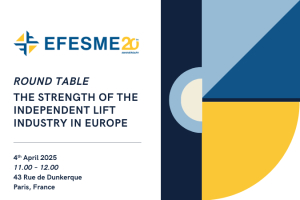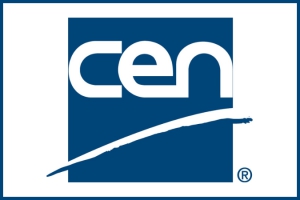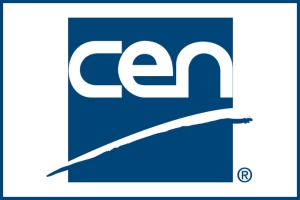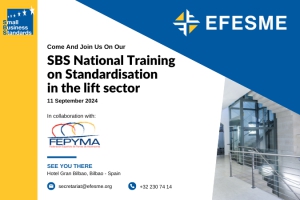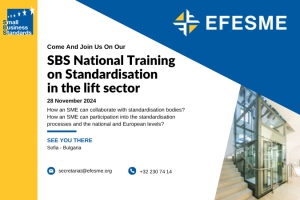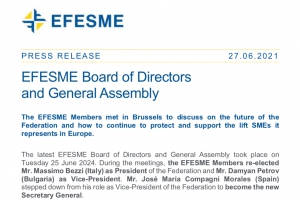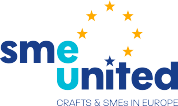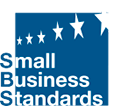
EFESME turns 20!
Twenty years of activity supporting European small and medium-sized enterprises in the lift sector. Twenty years of challenges and successes achieved through constant collaboration with national members, SMEs and the team of technical experts dedicated to the Federation's many activities.
To celebrate this happy anniversary and look forward to the future together, EFESME decided to organise a series of celebrations with its members in different EU countries.
The first of these events will take place on 4 April in Paris, together with ANPA, the French member of EFESME.
The event will be an opportunity to meet French lift SMEs and give them a new chance to meet directly with their European representatives, exchange information and discuss the main topics of the sector together.
The round table will focus on a series of topics and questions, to satisfy the most frequent curiosity and doubts of SMEs, and to give them a broader European perspective, such as:
- What are the weaknesses and strengths of SMEs in the lifts sector?
- Why don't SMEs in the lifts sector have a larger market share?
- What does the European dimension and the EFESME network bring to a local SME?
The event will be attended not only by French lift SMEs and EFESME representatives representing them at the European technical-political level, but also by other professional profiles involved in the sector, such as architects and engineers, property managers, builders, and so on. The event, the first of a series, will be an excellent opportunity to meet SMEs directly on the ground and engage with them at a time designed to be tailored to their needs and to give them the opportunity to engage in person with various parallel aspects of the sector.
EFESME would like to thank ANPA for its hospitality and excellent cooperation in organising this first example to kick off EFESME's 20th anniversary celebrations.
See the page dedicated to the 20th Anniversary celebrations HERE.
Find the dedicated press release HERE.
Contact the EFESME Secretariat at This email address is being protected from spambots. You need JavaScript enabled to view it. for any questions you may have on the event and/or the 20th Anniversary Celebrations!
EFESME newsletter - SEASON'S GREETINGS
The new version of standard EN 81-41 has been published
An important note to this article: the indications given relate to what the draft of the standard currently indicates, but only the text to be published will be valid, which might (difficult but might) differ from what the current text is.
The EN 81-41 - Safety rules for the construction and installation of lifts - Special lifts for the transport of persons and goods - Part 41: Vertical lifting platforms intended for use by persons with impaired mobility successfully passed the ‘formal voting’ phase that took place between June and August this year. A total of 16 CEN national committees approved the standard, while no committee voted against (100% against a required minimum of 55%). So, the so-called weighted vote was a success, with 100 % in favour (minimum required 65 %).
The last corrections and additions have been completed in light of the ‘lack of compliance’ that affected the standard last year.
The last step is that of publication by CEN and the European Commission on the OJEU, and for this reason the anticipations we give should still be considered as non-final as the document may be affected by changes/additions up to the last.
The standard specifies safety requirements for the manufacture, installation, maintenance and dismantling of electrically operated vertical lift platforms fixed to a building structure, intended for use by persons with reduced mobility:
- travelling vertically between predefined levels, along a guided route whose vertical inclination does not exceed 15°;
- intended for use by persons with or without a wheelchair;
- supported or sustained by means of sprocket and chain, ropes, chains, screw and nut, friction/adhesion between wheels and guide, guided chain, pantograph mechanism or hydraulic piston (direct or indirect)
- with closed compartment;
- with speed not exceeding 0.15 m/s;
- with load carrier not completely closed.
Compared to the previous version of 2010, the new EN 81-41 introduces the following technical changes:
- a requirement has been added regarding the detection of a person inside the load carrier (which is a car but not completely enclosed), which Austria wanted in order to prevent automatic operating of the carrier from the landing with people inside the carrier. If persons are detected inside the carrier, is not possible to operate the carrier in automatic way from the controls at landing;
The standard gives the requirements for the detection means, which detect presence of persons in the carrier:
- when activated, they must prevent a call from any landing control; and
- they shall be monitored failure; and
- in the event of failure, calls from any landing control shall be prevented; and
- they shall not override the electrical safety devices (described in a specific Table), even if the detection means has failed.
- the drive specification for the friction roller system;
- requirements for the traction drive have been introduced;
- requirements for the screw and nut drive have been revised and tightened (requirements for inspection, nut, fastening);
- requirements for unlocking the landing door lock were revised;
- the impact energy forces of the motorised landing door were revised (reduced);
- the toothed belt drive was added;
- the use of the term ‘platform’ versus ‘carrier’ has been revised
- all normative references of the mentioned standards have been dated [also in EN 81-31];
- a new Annex ZA was developed, which includes a detailed Table ZA.1;
- Updated normative references to the main standards EN 81-20 and EN 81-50 instead of EN 81-1 and EN 81-2 [also in EN 81-31].
Other new features include the introduction of a new Appendix F - informative on the machine's interface with the building. This appendix deals with topics such as the support of Guide Rails and the ventilation of the enclosed liftway.
With regard to the first aspect, the consideration underlying the, albeit brief, considerations in the informative appendix starts from the important assumption that the guides of the lifting platform are supported in such a way as to minimise the effects of the movement of the building structure to which they are connected.
The second aspect starts from the assumption, already expressed in EN 81-20, that the requirement to adequately ventilate the closed travel space of the platform is often contained in local building codes, either specifically or as a general requirement, just as it is given for any building space where machinery is installed or people are housed (for leisure, work, etc.).
Therefore, EN 81-41 does not and cannot give precise indications on specific requirements for ventilating such areas, since the closed platform travel space is part of a larger and often complex building environment. On the contrary, wanting to give specific requirements would risk creating a conflict with national requirements. However, the document in this appendix provides some very interesting and, above all, useful general indications for the design of proper platform ventilation.
Compared to the 2010 edition in the new version are deleted Annex F (informative) concerning the calculation of steel guides (very poor of information), and Annex G concerning “Friction/traction drive – Calculation and test for verification of traction conformity” (specific requirements introduced in the main text of the document.
Regarding exclusions, as in the 2010 edition, the standard does not specify additional requirements for:
- operation in severe conditions (e.g. extreme climates, strong magnetic fields);
- lightning protection;
- operation subject to special rules (e.g. potentially explosive atmospheres);
- handling of materials, the nature of which could lead to dangerous situations;
- vertical lifting platforms whose primary function is the transportation of goods;
- vertical lifting platforms whose carriers are completely enclosed;
- vertical lifting platforms prone to vandalism;
- hazards occurring during manufacture;
- earthquakes, flooding;
- firefighting, evacuation and behaviour during a fire;
- noise and vibrations;
- the design of concrete, hard core, timber or other foundation or building arrangement;
- the design of anchorage bolts to the supporting structure;
- type C wheelchairs as defined in EN 12183:2014 and/or EN 12184:2014
Finally, as with all harmonised standards, the document is not applicable to vertical lift tables intended for use by persons with reduced mobility that were manufactured prior to the date of its publication as EN.
This document constitutes a full revision of the standard. The main technical changes with respect to EN 81-41: 2010 are:
- requirement for a means for detection of a person on the carrier has been added;
- friction roller drive has been removed;
- traction drive requirements have been introduced;
- screw and nut drive requirements have been strengthened (inspection, safety nut, fixing requirements);
- landing door lock release requirements have been revised;
- power door contact forces have been reduced;
- toothed belts drive has been added;
- use of the word “carrier” vs “platform” has been revised;
- all normative references to other standards have been dated;
- a new Annex ZA, including a detailed Table ZA.1, has been developed.
The new version of standard EN 81-31 has been published
An important note to this article: the indications given relate to what the draft of the standard currently indicates, but only the text to be published will be valid, which might (difficult but might) differ from what the current text is.
The EN 81-31 - Safety rules for the construction and installation of lifts - Lifts for the transport of goods only - Part 31: Accessible goods only lifts successfully passed the ‘Formal Vote’ step that took place between July and August this year. A total of 18 national CEN committees approved the standard, while no committee voted against (100% against a required minimum of 55%). The so-called weighted vote was also a success, with 100 % in favour (minimum required 65 %).
We are therefore on the verge of the possible publication in the OJEU of the update of the previous version dating back to 2010.
What is it about?
EN 81-31 specifies the safety rules for new accessible goods only lifts with traction, positive or hydraulic drive,
- permanently installed and only used by users,
- serving fixed and permanent landing levels,
- having a carrier made of a single load carrying area,
- designed for the transportation of goods only,
- moving along a fixed path by rigid guide rails and inclined not more than 15° to the vertical,
- with rated speed not exceeding 1 m/s and
- covers accessible goods only lifts with rated load exceeding 300 kg and not intended to transport persons.
For the purpose of the EN 81-31, a goods only lift carrier is regarded as accessible where one of the following conditions is satisfied:
- floor area of the carrier is greater than 1,0 m2;
- depth of the carrier is greater than 1,0 m;
- clear height of the carrier is greater than 1,20 m.
- In case the carrier is without a roof, it is considered accessible when the clear height of the landing doors is greater than 1,20 m.
Two types of accessible goods only lifts are addressed:
- Type A, where the intended use is bound to the maximum rated speed of 0,30 m/s;
- Type B, where the intended use is bound to the maximum rated speed of 1,0 m/s.
In the previous version, Type A accessible lifts had to fulfil two conditions simultaneously:
- maximum travel 12 m;
- maximum rated speed of 0.30 m/s.
The first condition is no longer required in the newly approved (but not still published) version.
The standard has been updated with respect to the latest drafting rules. E.g. Chapter 3.2 on units of measurement and symbols has been deleted, Chapter 4 ‘list of significant hazards’ has been moved to Annex L (information).
Chapter 4 thus becomes the most important chapter of the standard, as it sets out the safety requirements and protective measures.
- Appendix B - normative - concerning the triangular release key has been deleted because it is redundant with EN 81-20.
- Annex K - informative- concerning the machine interface with the building is new. Along the same lines as EN 81-20, this Annex deals with topics such as the exchange of information between the machine manufacturer and the building owner, and the ventilation of the machine space and the well.
Finally, the exclusions. Like the 2010 edition, the standard does not cover:
This document does not cover:
- accessible goods only lifts:
- with more than one lift machine;
- where loading and unloading is automated, or the carrier floor is fitted with mobile devices (e.g. rollers) for loading and unloading purposes;
- intended to carry bulk loads (such as loose sand, gravel, etc.);
- with drive systems other than those stated in 4.8;
- lifting tables according to EN 1570-1 and EN 1570-2;
- lifting appliances, such as appliances with more than one carrier, skips, goods only lifts for construction sites, for underground applications, mine winding gear, goods only lifts on seagoing vessels and mobile offshore units, construction and maintenance appliances in wind turbines, goods only lifts specially designed and constructed for research purposes for temporary use in laboratories, goods only lifts specially designed and constructed for military or police purposes;
- safety during operation of transport, erection, repairs and dismantling of accessible goods only lifts;
- the use of translucent material for the walls of the well and machinery spaces, for the carrier with the exception of the landing doors vision panels;
- the use of programmable electronic systems in safety related applications for lifts (PESSRAL);
- hydraulic lifts where the setting of the pressure relief valve exceeds 50 MPa;
- any form of radiation except EMC;
- fire propagation;
- energy dissipation type buffers;
- the possibility of two simultaneous acts of imprudence and/or the abuse of instructions for use.
- ambient temperature in the well and machinery spaces lower than +5 °C and higher than +40 °C;
- health and safety of animals.
However, this document can usefully be taken as a basis.
Noise and vibrations are not dealt with in this document as they are not considered a significant nor relevant hazard for the actual type of the accessible goods only lifts.
1st SBS National Training on Standardisation in the lift sector

In the framework of the "Eliminar barreras" event organised by FEPYMA in Bilbao on 11 September 2024, EFESME and SBS will organise the first SBS national training on standardisation in the lift sector.
The event will create a very good opportunity to meet Spanish lift SMEs, with the aim to train and inform them about:
- The possibilities for lift SMEs and SME in all sectors to participate with their experts in standardisation processes at national, European and international level
- The possible forms of collaboration between SMEs and standardisation bodies
- The most recent updates from lift standardisation
- The risk and benefits for lift SMEs of the transition towards international standards
- The role of standards in lift SMEs daily work and how they can be tools to facilitate their job
Moreover, the day, which is already part of a series of events organised by FEPYMA to train and inform Spanish SMEs, will also see the development of a larger event entirely dedicated to breaking down any barriers that may prevent SMEs from fully participating in the lift industry as true protagonists, and to informing Spanish SMEs of the latest Spanish and European legislation in their sector.
EFESME and SBS thank FEPYMA for the opportunity to organise the training together and for the interesting combination with the Spanish event dedicated to the elimination of any barrier in the sector.
Contact the EFESME Secretariat at This email address is being protected from spambots. You need JavaScript enabled to view it. for any questions you may have on the event.
2nd SBS National Training on Standardisation in the lift sector
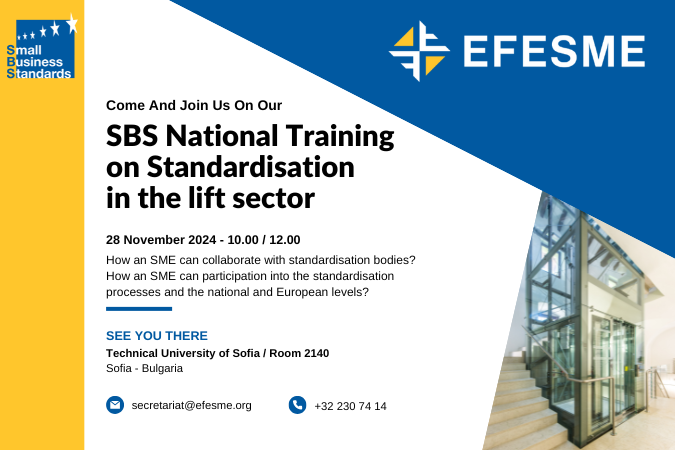
On 28th November, the second SBS national training on standardisation in the lift sector will take place at the Techinological University of Sofia, Room 2140, in Sofia, Bulgaria.
The event will be an excellent occasion to meet Bulgarian lift SMEs, and to train and inform them about the possibilities to participate with their experts in standardisation processes at national and European level, to work towards the writing and publication of SME-friendly standards.
The training will cover several topics of high relevance for lift SMEs, to give them proper information and the tools they need to keep being active actors, such as:
- The SBS report on SMEs inclusiveness in national standardisation
- The ongoing evolution of standards in the lift sector
- The several and different ways a SME can collaborate with the standardisation bodies
- How an SME can participation into the standardisation processes and the national and European levels
- The revised prEN81-41 and the new EN81-42
Contact the EFESME Secretariat at This email address is being protected from spambots. You need JavaScript enabled to view it. for any questions you may have on the event.
EFESME attends the NAEC 2024 United Convention
During the NAEC United Convention 2024, which took place in Atlantic City (NJ, USA) between 23rd and 26th September, EFESME and its President Massimo Bezzi participated in the Bridge Builders meeting, together with Elevator World Inc., IAEC, NAEC and CECA, who also acted as moderator of the meeting.
It was an important moment of confrontation, during which EFESME was also able to present topics and updates of fundamental importance for the sector in Europe and its SMEs, such as:
✅ The most recent news in European regulatory terms with the new versions of the standards EN 81-41 and EN 81-31, which saw EFESME experts particularly active in their respective WGs to develop SME-friendly texts;
✅ The importance and impact of the Right to Repair and the respective European Directive;
✅ The situation of the European lift market with a special focus on lift SMEs and their activities;
✅ As well as an analysis of the market itself developed by EFESME through a report produced by contacting its members and SMEs to assess the existence of a link between safety and modernisation within the European lift industry.
During the meeting, there was also ample opportunity to share and discuss together what the future challenges will be for a market that is increasingly competitive and complex, and influenced by new technologies, with all the opportunities and risks involved.
EFESME Board of Directors and General Assembly
The EFESME Members met in Brussels to discuss on the future of the Federation and how to continue to protect and support the lift SMEs it represents in Europe.
The latest EFESME Board of Directors and General Assembly took place on Tuesday 25 June 2024. During the meetings, the EFESME Members re-elected Mr. Massimo Bezzi (Italy) as President of the Federation and Mr. Damyan Petrov (Bulgaria) as Vice-President. Mr. José María Compagni Morales (Spain) stepped down from his role as Vice-President of the Federation to become the new Secretary General.
Mr. Compagni Morales takes over from Mr. Luciano Faletto (Italy), who held this position for years with dedication and commitment.
Wishing Mr. Compagni Morales the best of luck in his new role, EFESME would like to thank Mr. Faletto for the years he has enthusiastically dedicated to the Federation, in supporting its projects at both the technical and political levels, and its entire activity to protect European lift SMEs.
The EFESME Members also had the to discuss with the Federation’s technical experts the many activities carried out at European and international level with regard to standardisation, as well as the various projects and discussion tables in which EFESME is involved on behalf of European lift SMEs.
With renewed optimism, the EFESME Members reaffirmed their confidence in the Federation's activities and projects, with an ever-increasing focus and involvement of their associates and SMEs so that they can become more and more leading players in the European lift industry.
Empowering Europe's Lift Sector: A Manifesto for Growth

As the European Union prepares for its next chapter, it is crucial to ensure that the voices of small and medium-sized enterprises (SMEs) are heard loud and clear. SMEs represent the majority in the lift sector, playing a vital role in innovation, job creation, and economic prosperity. As EFESME, the European Federation representing these lift SMEs all around the continent, we proudly present our manifesto for the European Election, focusing on five key pillars: Economic Empowerment, Access to Finance, Digital Transformation, Sustainability and Corporate Social Responsibility, and Skills Development.
- Economic Empowerment: Our manifesto champions policies that foster a competitive environment for lift SMEs to thrive. We advocate for streamlined regulations, reduced bureaucratic burdens, and fair competition practices to unleash the full potential of lift SMEs in our sector.
- Access to Finance: Access to finance remains a critical challenge for many SMEs, not only in the lift sector. We call for initiatives that facilitate easier access to affordable loans and grants, including SME-friendly financial advice, and to the EU funding and projects.
- Digital Transformation: Embracing digitalisation is paramount for the future success of lift SMEs. We advocate for policies that promote the development of digital skills to provide innovative solutions tailored to the evolving needs of our industry; a fair access to data, tools, and documentation; and the development of truly European and global SME-friendly digital standards.
- Sustainability and Corporate Social Responsibility: We are committed to driving sustainability and corporate social responsibility within the lift sector. Our manifesto urges for SMEs-friendly business practices with a socio-environmental impact, the promotion of circular economy and repairability principles, to create a more sustainable future.
- Skills Development: Investing in the skills of our workforce is essential for staying competitive in a rapidly evolving global landscape. We call for comprehensive training programs and educational activities, as well as partnership with educational institutions, developed to be accessible to lift SMEs and provide them with the skills needed to adapt to technological advancements and market demands.
With our manifesto, we want to lay out a vision for a vibrant and prosperous lift sector in Europe, and the give our lift SMEs all the tools and the opportunities to thrive. By prioritising these five pillars, we want to work to create a SME-friendly business environment that can ensure that lift SMEs continue to drive innovation, create jobs, and contribute to Europe's economic growth and social well-being.
Together, let us empower Europe's lift sector and its SMEs to reach new heights of success.
Read and download the Manifesto HERE.
